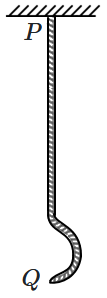1. \(0.16 \cos(4x_0-2t)\)
2. \(-0.16 \sin(4x_0-2t)\)
3. \(0.04 \cos(4x_0-2t)\)
4. \(-0.08\cos(4x_0-2t)\)
A wave travelling along a string is described by, \(y(x,t)=0.005 \text{ sin}(80.0x-3.0t),\) in which the numerical constants are in SI units. The wavelength and the period of the wave respectively are:
1. \(7.85 ~\text{cm}\) and \(2.09 ~\text{s}\)
2. \(7.85 ~\text{cm}\) and \(1.09 ~\text{s}\)
3. \(7.85 ~\text{cm}\) and \(0.09 ~\text{s}\)
4. none of these
A wave travelling along a string is described by, \(y(x,~t)=0.005 ~\sin(80.0x-3.0t),\) in which the numerical constants are in SI units. The displacement \(y\) of the wave at a distance \(x = 30.0~\text {cm}\) and time \(t=20~\text{s}\) is:
1. \(0.5~\text{mm}\)
2. \(5~\text{mm}\)
3. \(5~\text{m}\)
4. \(5~\text{cm}\)
1. \(1:2\)
2. \(1:1\)
3. \(\sqrt{2}:1\)
4. \(1:\sqrt{2}\)
| 1. | \(\dfrac43\) | 2. | \(\sqrt{\dfrac43}\) |
| 3. | \(\dfrac34\) | 4. | \(\sqrt{\dfrac34}\) |
| 1. | \(100~\text{m/s}\) | 2. | \(500~\text{m/s}\) |
| 3. | \(600~\text{m/s}\) | 4. | \(10,000~\text{m/s}\) |
| 1. | \(0.5~\text{s}\) | 2. | \(0.6~\text{s}\) |
| 3. | \(0.4~\text{s}\) | 4. | \(0.1~\text{s}\) |

| 1. | increases | 2. | decreases |
| 3. | first increases and then decreases | 4. | remains constant |
(take \(g=10~\text{m/s}^2\) )

1. \({\dfrac {1} {\sqrt {10}}}~\text s\)
2. \({\dfrac{3} {\sqrt {10}}} ~\text s\)
3. \( {\sqrt{\dfrac{2}{5}}} ~\text s\)
4. \(\dfrac {\sqrt {5}} 2~\text s\)
A steel wire \(0.72~\text{m}\) long has a mass of \(5\times10^{-3}~\text{kg}\). If the wire is under tension of \(60~\text{N}\), the speed of transverse waves on the wire will be:
1. \(85~\text{m/s}\)
2. \(83~\text{m/s}\)
3. \(93~\text{m/s}\)
4. \(100~\text{m/s}\)






